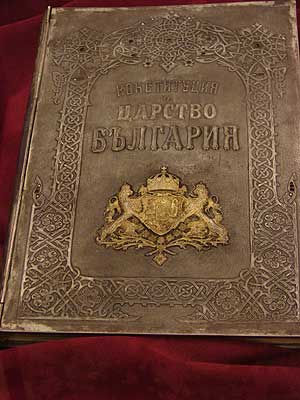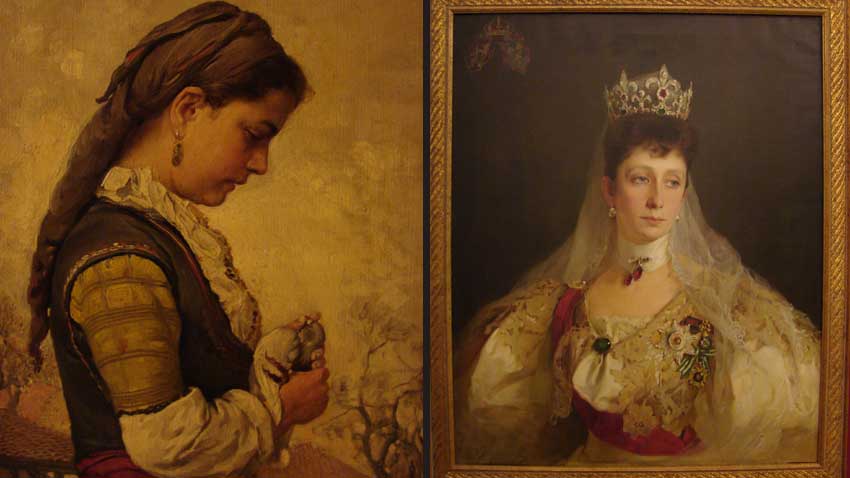Insigniaof royal power, stylish Bulgarianorders, a diplomaticsuit,richlydecoratedwithtinsel, traditional costumes withbeautiful embroidery, paintings by famous artists...All this andmany otheritemsare on display at the exhibitionThe Birth of the Third Bulgaria:Sofia and the Sofia Region in the Late 19, Early 20 c.
"That was a time when the Bulgarian state was reborn; it resurrected as a phoenix from its non-existence after five centuries of Ottoman rule', art historian Prof. Mila Santova says in an interview for Radio Bulgaria. “Back at that time Bulgaria was looking for ways to be constituted again. It borrowed the European model, because its land has always been part of the civilization of Europe. This exhibition shows the so-called Silver Constitution from 1911, a copy of the Constitution with silver plating.”
 In 1911 the Fifth Grand National Assembly carried out comprehensive edition of the 1879 Tarnovo Constitution after Bulgaria had been officially proclaimed kingdom in 1908. "The Silver Constitution was the basic document of the state regulating Bulgaria as a country created in tune with the logic of European structures”, Prof. Santova goes on to say. “In fact, it was this Constitution that catered for the integration of Bulgaria and Bulgarians in Europe. Of course, this integration had started earlier, as many Bulgarians before the Liberation studied abroad. This was a circle of leading brainworkers who played an important role in the constitution of a new modern state in the Bulgarian lands.”
In 1911 the Fifth Grand National Assembly carried out comprehensive edition of the 1879 Tarnovo Constitution after Bulgaria had been officially proclaimed kingdom in 1908. "The Silver Constitution was the basic document of the state regulating Bulgaria as a country created in tune with the logic of European structures”, Prof. Santova goes on to say. “In fact, it was this Constitution that catered for the integration of Bulgaria and Bulgarians in Europe. Of course, this integration had started earlier, as many Bulgarians before the Liberation studied abroad. This was a circle of leading brainworkers who played an important role in the constitution of a new modern state in the Bulgarian lands.”
The items in the exhibition about the Third Bulgarian Kingdom come from various museums in Sofia and from a private collection. It is arranged at the National Museum of Bulgarian Fine Art housed in the former Royal Palace in the capital city. It has a special booth called Camera Obscura where visitors can sit and watch old footage provided by the Bulgarian National Film Archives and an extensive slide show.
"For present-day viewers it is curious to find out while watching either old photographs or footage that the streets of Sofia back in the late 19 and early 20 c. saw both passersby dressed up according to the latest European trends and folk wearing the traditional costumes of the region. This attests to the complex amalgam of Bulgaria's public life at that time. In a token of solidarity with traditions, the royal family used to dress and get photographed in traditional Bulgarian costumes from time to time. The exhibition includes such a photo of King Ferdinand, his kids and second wife all clad in traditional costumes. This symbolizes the two pillars and sources of the modern Bulgarian culture, namely, the European trends and local folklore.”

The exhibition highlights portraits of the royal family, and of prominent Bulgarians like the great poet, novelist and playwright Ivan Vazov and strong-willed rebel-turned-politician Stefan Stambolov. On the other hand, visitors can feast their eyes on wonderfully portrayed peasants in the works of renowned artist Ivan Mrkvicka. One of the items on display is a large porcelain set, a winner in a women's competition held under the aegis of Princes Evdokia. It is the work of Alexandra Hadjivultcheva from the family of Bulgaria's pioneer revival leader, monk St. Paisii of Hilandar, the author of Slav-Bulgarian History. His book paved the way to the Bulgarian National Revival of 18-19 c. The porcelain set has been decorated by artist Miss Hadjivultcheva with a nice motif borrowed from the traditional Bulgarian embroideries. Visitors will find it interesting to learn more about the set and more notably about a prominent family which has influenced the cultural process in this country.
English: Daniela Konstantinova
For the first time, two of the most mysterious archaeological sites in the Eastern Rhodopes have been studied in detail from air. Bulgarian archaeologists scanned the Harman Kaya rock complex near the village of Bivolyane and the ancient Asara fortress..
After the Liberation in 1878, Bulgaria began to develop at a pace that would make up for the centuries-long absence from the world history map. Young Bulgarians graduated from prestigious European universities and took their knowledge to their homeland..
One of the three biggest Hebrew holidays, Pesach (Passover) starts at sundown (5 PM) on 22 April and ends on 30 April. It is a movable feast, falling after the 14 th day of the spring month of Nisan which starts after the spring equinox with the..
After the Liberation in 1878, Bulgaria began to develop at a pace that would make up for the centuries-long absence from the world history map. Young..
For the first time, two of the most mysterious archaeological sites in the Eastern Rhodopes have been studied in detail from air. Bulgarian archaeologists..

+359 2 9336 661
